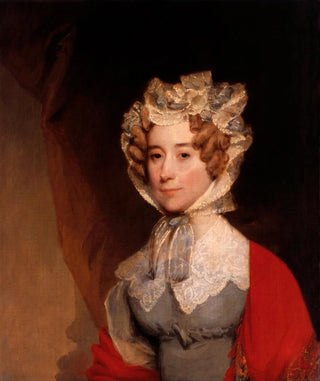Art print | Louisa Catherine Johnson Adams - Gilbert Stuart


View from behind

Frame (optional)
In the fascinating world of early 19th-century American painting, the artwork "Louisa Catherine Johnson Adams" by Gilbert Stuart stands out for its elegance and psychological depth. This portrait, which immortalizes the wife of John Quincy Adams, the sixth President of the United States, goes beyond a mere physical representation. It evokes a story, a personality, and a tumultuous political context. Through this piece, Stuart manages to capture not only Louisa's features but also her essence, intelligence, and role in the society of her time. This painting, a true emblem of portrait art, offers an immersion into an era where art and politics intertwined, revealing the social and cultural dynamics of emerging America.
Style and uniqueness of the work
Gilbert Stuart's style is characterized by exceptional technical mastery and meticulous attention to detail. In "Louisa Catherine Johnson Adams," he employs a palette of rich, nuanced colors, creating a striking contrast between the softness of the skin tones and the depth of the drapery. Louisa's eyes, bright and expressive, seem to tell a story, engaging the viewer in a silent dialogue. Stuart excels in rendering textures, whether through the satin of the dress or the delicacy of the hair. This portrait is also marked by a carefully balanced composition, where Louisa's posture, slightly turned to the left, suggests both a certain reserve and innate confidence. Every element of the work, from accessories to facial expressions, contributes to creating an intimate and reflective atmosphere, allowing the viewer to feel the personality of the sittee beyond her appearance.
The artist and his influence
Gilbert Stuart, born in Rhode Island in 1755, is often regarded as one of the greatest American portraitists of his time. His influence on American art is undeniable, having trained many artists and established quality standards in portraiture. Stuart had the honor of painting numerous iconic figures of his era, including presidents and influential personalities. His approach to portraiture goes beyond simple representation; he seeks to capture the soul of his subjects, endowing them with

Matte finish

View from behind

Frame (optional)
In the fascinating world of early 19th-century American painting, the artwork "Louisa Catherine Johnson Adams" by Gilbert Stuart stands out for its elegance and psychological depth. This portrait, which immortalizes the wife of John Quincy Adams, the sixth President of the United States, goes beyond a mere physical representation. It evokes a story, a personality, and a tumultuous political context. Through this piece, Stuart manages to capture not only Louisa's features but also her essence, intelligence, and role in the society of her time. This painting, a true emblem of portrait art, offers an immersion into an era where art and politics intertwined, revealing the social and cultural dynamics of emerging America.
Style and uniqueness of the work
Gilbert Stuart's style is characterized by exceptional technical mastery and meticulous attention to detail. In "Louisa Catherine Johnson Adams," he employs a palette of rich, nuanced colors, creating a striking contrast between the softness of the skin tones and the depth of the drapery. Louisa's eyes, bright and expressive, seem to tell a story, engaging the viewer in a silent dialogue. Stuart excels in rendering textures, whether through the satin of the dress or the delicacy of the hair. This portrait is also marked by a carefully balanced composition, where Louisa's posture, slightly turned to the left, suggests both a certain reserve and innate confidence. Every element of the work, from accessories to facial expressions, contributes to creating an intimate and reflective atmosphere, allowing the viewer to feel the personality of the sittee beyond her appearance.
The artist and his influence
Gilbert Stuart, born in Rhode Island in 1755, is often regarded as one of the greatest American portraitists of his time. His influence on American art is undeniable, having trained many artists and established quality standards in portraiture. Stuart had the honor of painting numerous iconic figures of his era, including presidents and influential personalities. His approach to portraiture goes beyond simple representation; he seeks to capture the soul of his subjects, endowing them with






